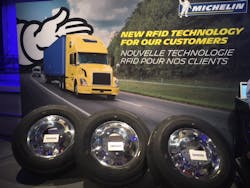More regulations in store for truck tires, technology
MONTREAL, QUE. Incoming regulations are expected to bring more demand on technology for truck tires that will reduce resistance and noise, according to Serge Lafon, head of Group Michelin Truck.
During Michelin’s Movin’On sustainable mobility event here in Montreal this week, Lafon told reporters that better, safer and cleaner mobility has been a trend within in the trucking industry for some time now, but that improvements still need to be made.
“We have seen that over time, we need to improve the ride [of tires] because the trucks are getting so much time on the road,” Lafon explained.
“It still needs improvement, but we need to make sure that when we use materials that go in the direction of less rolling resistance then it doesn’t degrade, so we need to upgrade that and that’s what we’re doing," he added. "In terms of noise, it’s getting more and more important but there are not so many regulations. In coming years, we expect more regulations and especially in the low-end segments of the trucks – the less than 20-ton segment – will be more subsequent to regulations on noise in the future.”
In an effort to address the regulatory and fleet demands of truck tires, Lafon said Michelin incorporated RFID tags in its tires, which used to be just a concept.
He noted the company added RFID in its technology center about 10 years ago and just recently launched it. So this year, one tire out of two will be produced and sold with an RFID chip, he added. Almost all tires sold in North America this year will be sold with chips and about more than 90% in Europe.
However, asked whether or not RFID tags would be viable in an autonomous market, Lafon said: “RFID, per se, will not be needed in an autonomous market as it will not report or record real-time data.”
Overall, when it comes to autonomous driving technology, Lafon said he believes it will be more important in the truck business than with passenger vehicles due to the professional truck driver shortage.
“Driving a truck is tough work. So many people are tending to do something else where they are better paid or less difficult,” Lafon explained. “So in that context, getting autonomous vehicles are said to make it easier.”
During a panel discussion on connected vehicles, cybersecurity and the user experience here at Movin’On, Joachim Damasky noted that since user error makes up about 90% of all accidents, autonomous vehicles could be the way to go to address a lot of global safety issues.
“We will not have autonomous driving or fully autonomous driving in the near future,” he explained, noting that it will take about 10 years for autonomous vehicles to be fully implemented," he said.
Dan Galves, senior vice president, chief communication officer for Mobileye, was also on the panel. He said autonomous vehicles will end up taking the steering wheel out of people’s hands and giving people their time back and allowing them to leave work an hour earlier because they can do their emails while driving instead of focusing on the road.
“It’s not going to happen tomorrow,” he explained. “We are going to go through a period of 8-10 years of vehicles going through more and more training. It scares us to have incidents happening with companies that are not as safe as they should be with the technology and the way the public perceives it.”
Fellow panelist Ian Drew, chairman Tantalum Corporation, said in order for the autonomous business model to succeed, it needs to be driven outside the car industry and focus on day-to-day security.
“How do you put security in cars to make sure no cars get hacked,” he asked. “As soon as we’re connecting cars, there are bad guys out there and they will hack them. Make sure the protective software gets integrated and that we’re not driving around for five years with gaping holes. “
“Make it as hard as possible to be hacked and fix it as quickly as possible” Drew concluded. “Make sure everybody is connected. There will have to be legislation put in.”
About the Author

Cristina Commendatore
Cristina Commendatore is a past FleetOwner editor-in-chief. She wrote for the publication from 2015 to 2023.
